This post will be a long one all about the sewing details and the pattern changes I made. My next post will show the finished coat. I am not a fan of coats with zippers, particularly on anything longer than a hip length type of coat or jacket. So while I loved this pattern I knew from the moment I saw it that if I sewed it I would change that zipper to a hidden buttonhole placket. In fact, I did test this pattern for Pauline, and mentioned that to her in my feedback. For the final pattern she has included the center front line on both front pattern pieces (which are not symmetrical) so that makes it very possible to do this change.
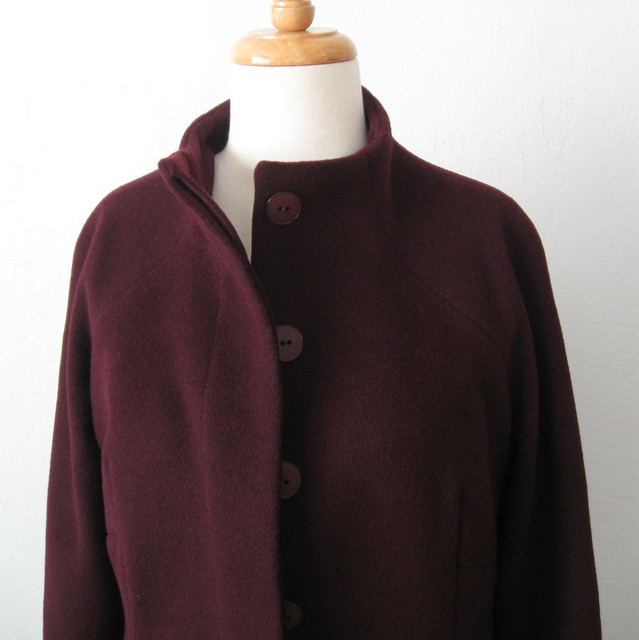
Here's a look at the pattern example from the Pauline Alice website and the line drawing. I love the curved seaming and the flared skirt. Her patterns always have some interesting details that make them unique - which is certainly something I look for in a pattern.

Here's a look at the inside of the coat before I attached the facings and placket. Actually the coat center fronts in my version are the standard front that you would find on any coat or jacket pattern, I wanted you to see the interfacing I applied. I think in the pattern instruction you apply the interfacing to the facings, both the front facings and the neck facings, but I just find that more interfacing is almost always better. A coat of this style and fabric needs to be supported at the neckline and hang on the shoulders without sagging in that area. So I added weft interfacing around the neck, and even down the shoulder seams about 10 inches, both front and back. Here you can see the coat fronts overlapping as they would in a regular button front coat pattern.
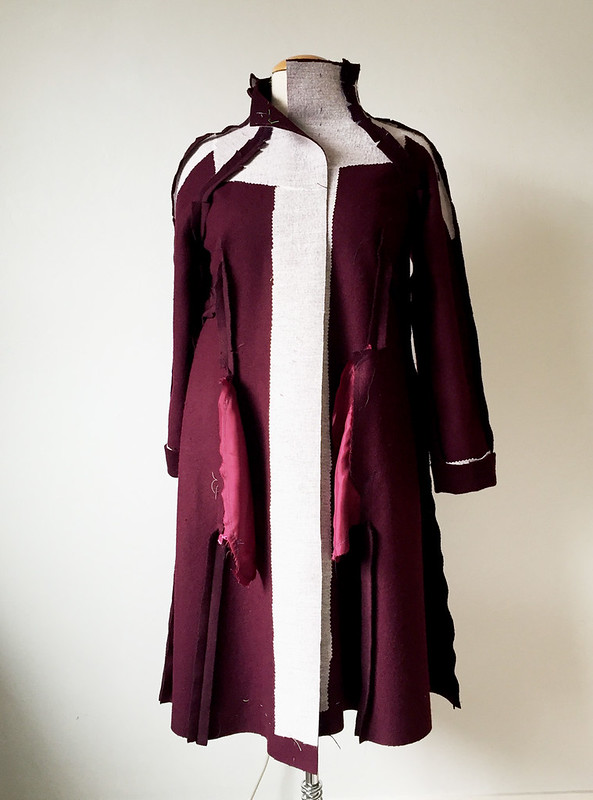
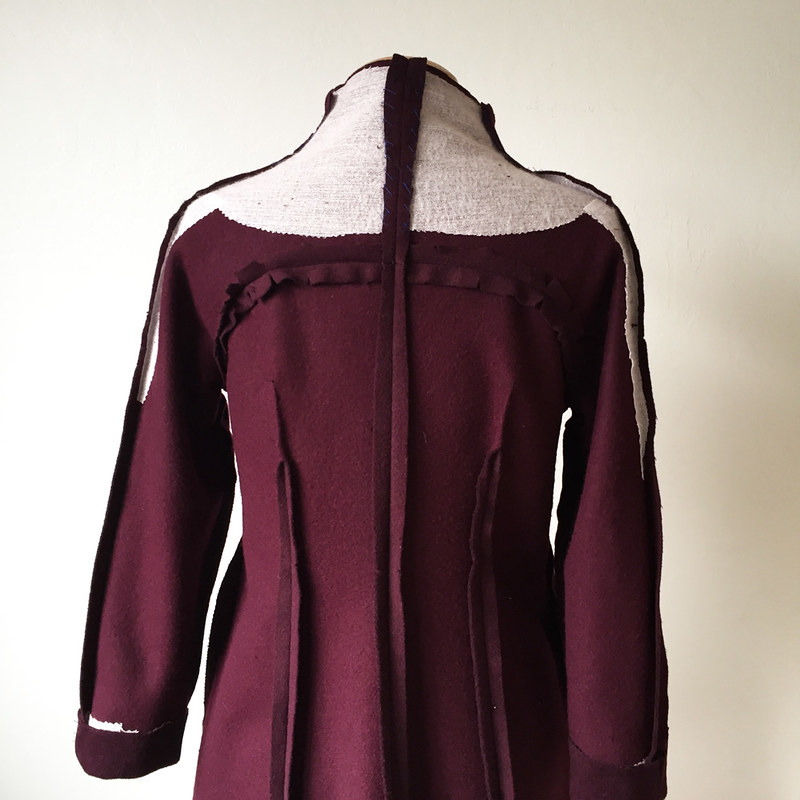
Sometimes I wonder when I show the insides of garments as I am working on them if readers think they look like a mess? But in a lined garment I have absolutely no concern about how the inside looks. It can have 3 different colors and types of interfacing, applied wherever I think it's needed to get the outside looking perfect. As long as there is a lining then who cares? And I never ever serge the edges. That just adds bulk and thread - the opposite of what I want the seam allowances to do which is disappear when pressed so that the outside is smooth and unmarred. Also the curved seams needed quite a bit of clipping and notching, being that they curve in different directions sometimes they need clipping to release the fabric and in other spots a few small notches so that the seam bulk can lay flat and not create a bump where the seams curve. I should do a post on that one of these days, where to clip and where to notch...
Ok - enough on interfacing, onto the hidden buttonhole placket. I have had a number of comments asking how to do it so here goes. The first part of this information is specific to this pattern, but the principle of how to make the hidden buttonhole placket can be applied to any garment.
Here's the RIGHT FRONT pattern piece of this pattern. Remember that the pattern has 2 different front pieces, a LEFT and a RIGHT because the design is for a zipper that is covered and offset under the right front. But for a hidden buttonhole placket the coat needs to have two fronts that are the same, and that cross over the center front line allowing space for the buttonholes. Whether they are hidden or regular buttonholes on one side this re-design would be the same. I used the RIGHT front pattern piece as it has the center front line. (which on this pattern is the grain line arrow, also marked as Center Front. Note that on any coat, jacket or shirt pattern the horizontal buttonholes cross over this center front line. In the example below I'm using the smallest size (34) on the multi-size pattern because it is just easier to draw on this. For my coat I traced the size 38 and working on my traced pattern piece.
1. Mark the center front, and determine the buttonhole placement. This is a bit tricky for this coat where the neckline is high, as you want the neck to stay closed but gets to be a bit of a small space for your fingers to fasten the top buttonhole. It worked out OK as I did it, but it would also be really nice to have one button which showed at the top and then the rest as hidden. The buttonholes in this thick fabric cross over the center front about 1/4".
2. From the center end of the buttonhole draw the finished edge line. Which is also the stitching line of the facing. I decided to use 1/2" from the end of the buttonhole. On the pattern that happened to be the fold line if the zipper had been there which sounded about right. Then I added a 5/8" seam allowance past that finished edge stitching line (labeled as new cutting line in the photo below)
3. Straighten out the top edge of the coat above the buttonhole. These will be overlapping when the coat is finished so they need to be able to overlap evenly.

These changes turn this pattern piece into the coat front for both the left and the right side. The placket is only applied to one side, and the other side is sewn with a facing just as a regular coat.
To make the coat facing, which is necessary since the facings in the pattern are also asymmetrical due to the zipper design, I used this new updated coat front, overlaid the lining side piece and just drew a facing that would match up to the side front lining piece. This coat definitely has a number of pieces because the neckline has some facings that mirror the shape of the sleeve and then attach to the lining. But I could use all of them except the center front facing which needed the redesign.
Placket How To: I actually didn't take a lot of photos when I was doing the placket portion as I was in a super time crunch to finish this, but I did write a post on Craftsy which is a step-by-step tutorial that can be applied to a variety of garments. If you are interested then take a look at that. As a condensed version here is a composite of the photos in that tutorial, but really - take a look at the Craftsy link, you will be able to see exactly how it is done.
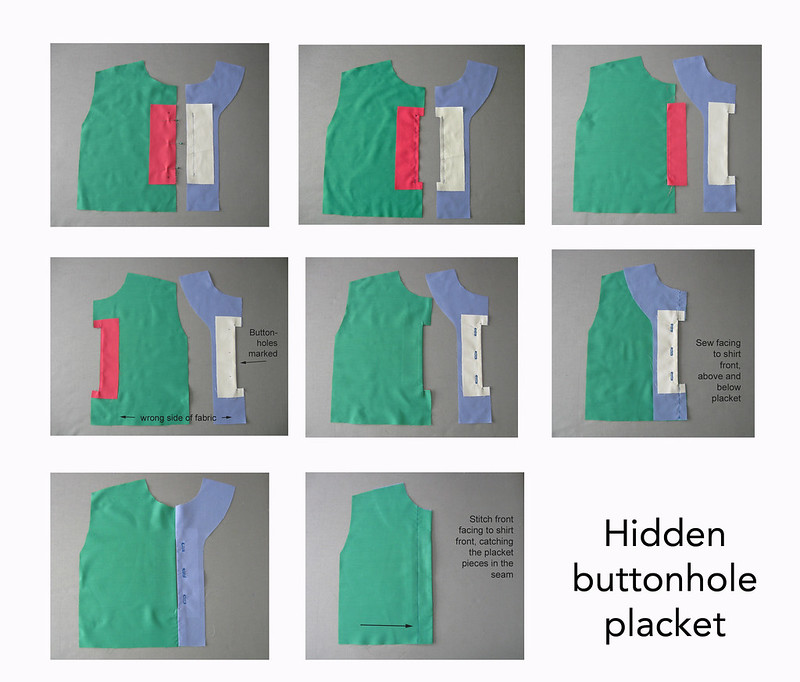
After all the sewing of facing etc, this is what you end up with. So the idea is the same on the wool coat - just a bit more tricky with a thick fabric.
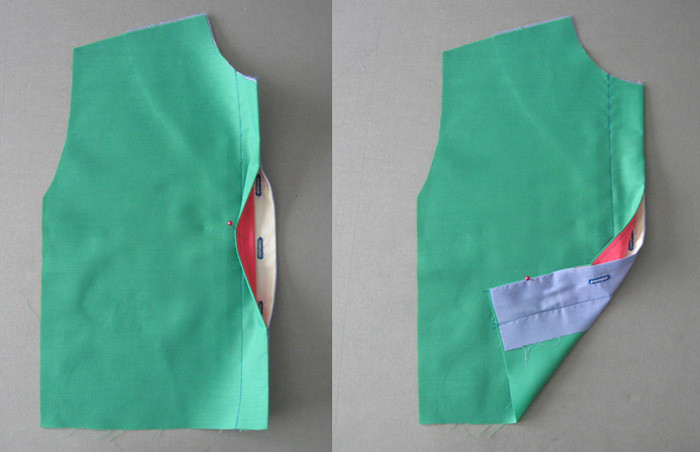
With the coat, the placket adds an extra two layers of fabric so I knew that I couldn't do it in the wool or it would be about 1/2" thick with all those layers. I decided to use silk charmeuse in the placket for the two extra layers and found the perfect color at Stone Mountain. I only needed 1/3 of a yard and cut two strips of 6 inches wide. While I wanted them to be thin they did need some support so I used Sheer Elegance Light in black on both pieces of charmeuse. Also on the coat facings, the same interfacing.
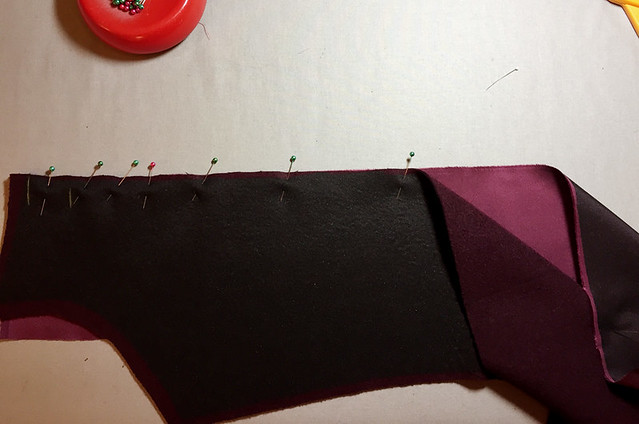
The silk and the coat facing are sewn right sides together. I did cause myself a lot of extra work because I couldn't quite decide where I wanted the placket open edge to start on the coat front, so I actually played around with it on the coat. I do not recommend! It's better to figure that out beforehand, I could have experimented with some scraps and figured out all the measurements. Live and learn.
I posted this photo on Instagram which illustrates that point exactly - the stitched edges of the bottom of the placket sides don't match and I had to do some extra work and trimming to make them equal.
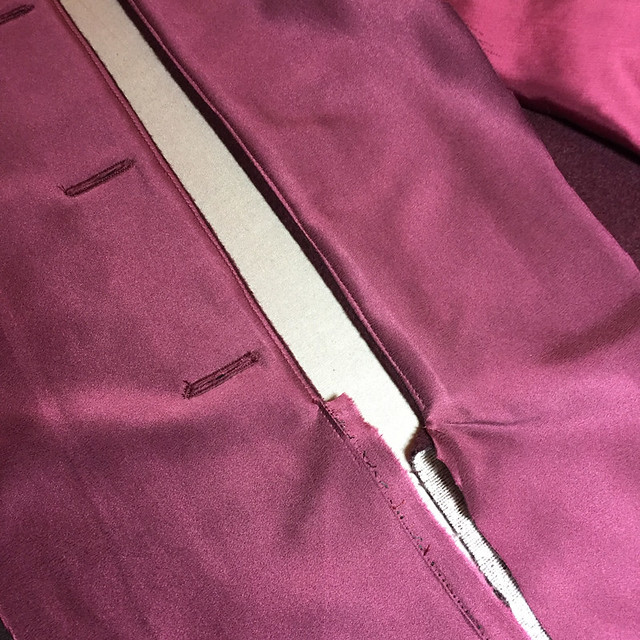
But I finally got it all worked out and stitched the front facing and placket to the coat front. Oh, I forgot to say, even before that, the buttonholes needed to be made. And this time I remembered to stitch them horizontally (unlike the Bamboo coat where I sewed them vertically, to my great annoyance). That pattern actually has a hidden buttonhole placket so if you want a coat with that feature then that is the pattern for you, and a good way to get the hang of the construction. Although the welt pocket steps on that pattern - seemed so complicated and not at all the way I would do it).
Here's how the coat front looks on the inside.

And all buttoned up. The lighting in my sewing room plus probably my photography skills make me crazy and the same thing looks a different color in various images.
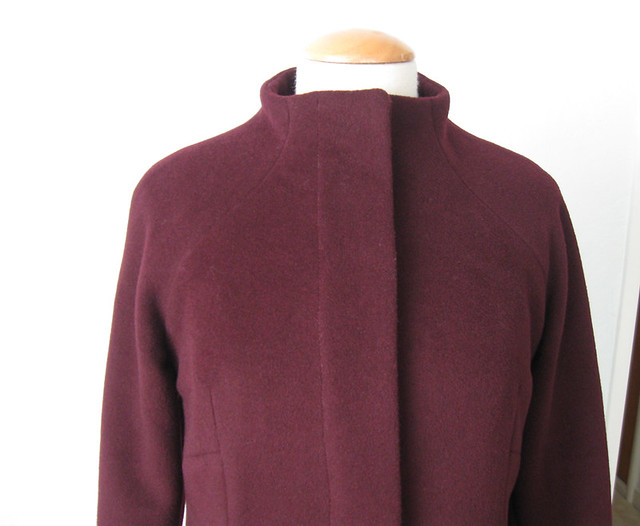
And once all is done, sewing on the buttons. Oh I hate sewing on buttons....But hey, we've come this far and a coat needs buttons. My method: ONE AT A TIME! Yes, I sew the buttons on one at a time. Start with the top. Sew on. Button up. Mark # 2. Sew on. Button both up. Mark # 3 and so on until finished. Because why? Because I can't stand it when one button is just ever so slightly out of place and tugs at the coat front. Remember the Quart coat? I sewed those bleeping buttons on multiple times until I got the button alignment and the plaid matching just right.
This is a good view of the completed placket. The silk insides are nicely hidden but the color match couldn't be better. I did hand stitch the edge of the placket closed, halfway between each buttonhole so that it wouldn't flop open and that worked really well. To create enough space for the buttonhole shank I taped two toothpicks together. A thick coat means the buttons need to be sewn on with a good 1/8 - 1/4" of space, in order to fit into the buttonhole and rest on the top of the coat without strain.
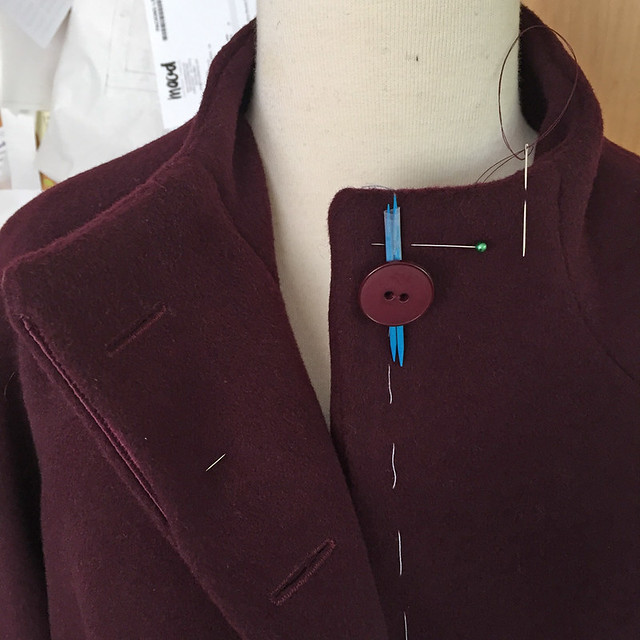
OK - that's the scoop on my playing around with plackets. Up next - I have great photos of the completed coat modeled by the lovely owner.
And a backlog of other stuff to post here. Told ya I was going to blog more this year!
Happy - is it still Winter? - Sewing, Beth
Man, the weather is weird! My garden doesn't know what to do with itself, some things are blooming and others are thinking, what? where's the spring showers. Which don't look like they are arriving any time soon and people are starting to mention the dreaded "drought" word again. Yikes, again? after our nice rainy winter last year. But on the other hand, it is supposed to be about 72°F for at least the next week or so. California sunshine - hey, we just have to live with it, the good and the bad 😎.
Today's garden picture. I wish I could remember the name of this Salvia, it has turned out to be a weird plant, which I put in last spring, and it grew and grew, to 6 feet tall but never bloomed. And then recently out popped these flowers at the end of the long stalks. The color is fantastic but it's a bit of an odd one .However it has passed the bloom test - so it's a keeper for now.
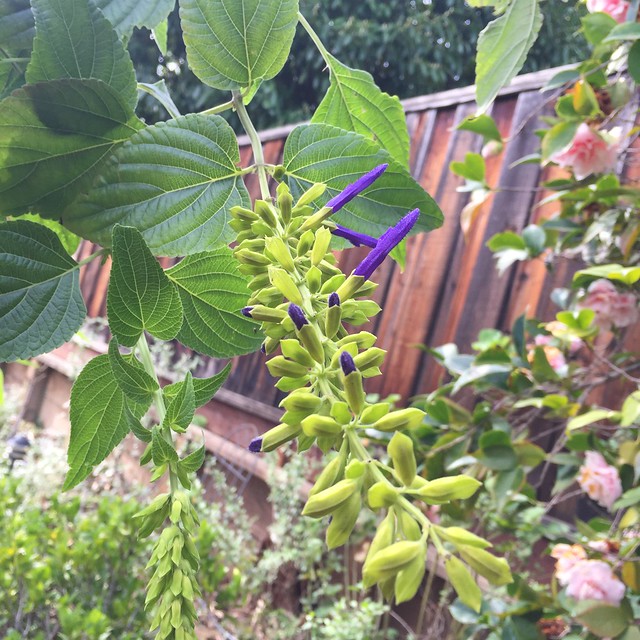











I do so love seeing all the inner juicy details - just love your hidden button placket!
ReplyDeleteOutstanding job, thanks for sharing! The pattern looks quite interesting too!
ReplyDeleteExceptional blog post, great information. Beautiful coat and thanks for sharing.
ReplyDeleteGreat post, Beth! I wish I was further along in my sewing skills so that I could put all this to use immediately. I can't wait to see the coat modeled, but I have to say it is gorgeous! I love the style and the color is stunning. Somebody is very lucky to receive such a fabulous garment!
ReplyDeleteThe coat is so gorgeous!!! I love the pattern you chose, and the adjustments you made. I look forward to seeing how the coat looks worn. Splendid job!
ReplyDeleteCute coat! I love to see the inside photos. I'm still learning where to put the interfacing. Your insides are very neat compared to mine :)
ReplyDeleteI love this coat! I've bookmarked your post because I have this pattern on its way to to me right now and I know I can use all the help I can get. Seeing your coat just makes me so anxious to get my hands on that pattern. I've been thinking about making mine for spring in a blue on blue flowered Liberty of London denim I've had in my stash for almost 2 years and lining with a lovely silk I just happened to have too :)
ReplyDeleteSalvia is limelight. Mine is cut back to sticks now (in SF) so yours is blooming????
ReplyDeleteTo die for. It's a fabulous coat, and while I am not making a winter coat this year, this goes on my list for next year. My only question is how would you make an fba in this? I have a couple of thoughts on how I'd do it, but I'd love to hear what you think.
ReplyDeleteBeautiful coat, I love seeing the insides. Thanks for the post.
ReplyDeleteGorgeous, well-made coat! Love it! :)
ReplyDeleteWhat a gorgeous coat in a beautiful colour. Love all the details here, though I find hidden button plackets enough trouble in shirts so am not planning on tackling them in a coat anytime soon (if I do, I know where to come for advice now)! I do the one by one sewing on button method too, I've learnt over the years that I'd rather it took longer to do with guaranteed results than having to redo them!
ReplyDeleteOh my goodness! The jacket is so beautiful. That front closure is perfect:) Thank you for sharing the details. Well done!
ReplyDeleteBeautiful! And thanks for posting all the details.
ReplyDeleteI’d never really thought about how to construct a hidden button placket but your example with the four colours of fabric makes it very clear.
I love this coat pattern, but not the zipper front. Your finished version with the hidden placket is more appealing to the eye than the zipper one on the pattern model. Thanks for the detail on how you did the hidden placket!!
ReplyDeleteSo that's what you did? Thank you for these details. I'll definitely come back and try this on a jacket this year. Cheers Beth :))
ReplyDeleteSuch a great blog post!! thanks so much
ReplyDelete